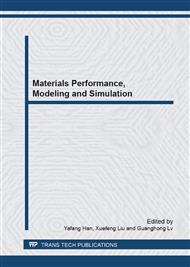[1]
O. Wachter, G. Brummer, Experiences with austenitic steels in boiling water reactors, Nucl. Eng. Des. 168 (1997) 35-52.
DOI: 10.1016/s0029-5493(96)01308-8
Google Scholar
[2]
L. Peguet, B. Malki, B. Baroux, Influence of cold working on the pitting corrosion resistance of stainless steels, Corros. Sci. 49 (2007) 1933-(1948).
DOI: 10.1016/j.corsci.2006.08.021
Google Scholar
[3]
Z. Witold, A. Abduluyahed Ayad, J. Kurzydłowski Krzysztof, TEM studies of dislocation substructure in 316 austenitic stainless steel strained after annealing in various environments, Mater. Sci. Eng. A. 249 (1998) 91-96.
DOI: 10.1016/s0921-5093(98)00578-4
Google Scholar
[4]
X. Feaugas, On the origin of the tensile flow stress in the stainless steel AISI 316l at 300 K: back stress and effective stress, Acta Mater. 47 (1999) 3617-3632.
DOI: 10.1016/s1359-6454(99)00222-0
Google Scholar
[5]
S. Takashi, M. Yoshinor, Evaluation of the dislocation density and dislocation character in cold rolled Type 304 steel determined by profile analysis of X-ray diffraction, Acta Mater. 59 (2011) 4314-4322.
DOI: 10.1016/j.actamat.2011.03.055
Google Scholar
[6]
R. Oltra, M. Keddam, Application of impedance technique to localized corrosion, Corros. Sci. 28 (1988) 1.
Google Scholar
[7]
R. de Levie, Advances in Electrochemistry and Electrochemical Engineering 6 (1967) 329.
Google Scholar
[8]
M.C. Petit, M. Cid, M. Puiggali, Z. Amor, An impedance study of the passivity breakdown during stress corrosion cracking phenomena, Corros. Sci. 31 (1990) 491.
DOI: 10.1016/0010-938x(90)90151-t
Google Scholar
[9]
T.Y. Jin, Y.F. Cheng, In situ characterization by localized electrochemical impedance spectroscopy of the electrochemical activity of microscopic inclusions in an X100 steel, Corros. Sci. (2011).
DOI: 10.1016/j.corsci.2010.11.026
Google Scholar
[10]
G. M Gutman, Mechanochemistry of materials. London: Cambridge International Science Publishing, (1998).
Google Scholar
[11]
W. Li, D.Y. Li, Variations of work function and corrosion behaviors of deformed copper surfaces, Appl. Surf. Sci. 240 (2005) 388-395.
DOI: 10.1016/j.apsusc.2004.07.017
Google Scholar
[12]
W. Li and D.Y. Li, Effects of dislocation on electron work function of metal surface, Materials Science and Technology 18(2002)1057.
Google Scholar
[13]
ASTM (1994) DESIGNATION A 262-293: 1.
Google Scholar
[14]
K.R. Trethewey, M. Paton, Electrochemical impedance behaviour of type 304L stainless steel under tensile loading , Materials Letters, (2004).
DOI: 10.1016/j.matlet.2004.02.048
Google Scholar
[15]
M. Sahal, J. Creus, R. Sabot, X. Feaugas, Consequences of plastic strain on the dissolution process of polycrystalline nickel in H2SO4 solution, Scripta Materialia, 51 (2004) 869-873.
DOI: 10.1016/j.scriptamat.2004.07.004
Google Scholar
[16]
Y.H. Huang , F.Z. Xuan, S.T. Tu, I. Takamoto, Effects of hydrogen and surface dislocation on active dissolution of deformed 304 austenitic stainless steel in acid chloride solution, Mater. Sci. Eng. A. 528 (2011) 1882-1888.
DOI: 10.1016/j.msea.2010.10.055
Google Scholar
[17]
C.M. Rangel, T.M. Silva, M. da Cunha Belo, Semiconductor electrochemistry approach to passivity and stress corrosion cracking susceptibility of stainless steels, Electrochim Acta. 50 (2005) 5076.
DOI: 10.1016/j.electacta.2005.03.064
Google Scholar
[18]
J.L. Lv, H.Y. Luo, Electrochemical investigation of passive film in pre-deformation AISI 304 stainless steels. Appl. Surf. Sci. Doi: 10. 1016/j. apsusc. 2012. 08. 058.
Google Scholar


